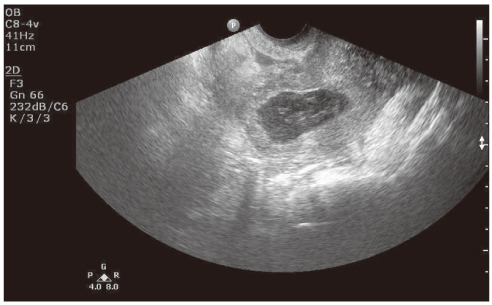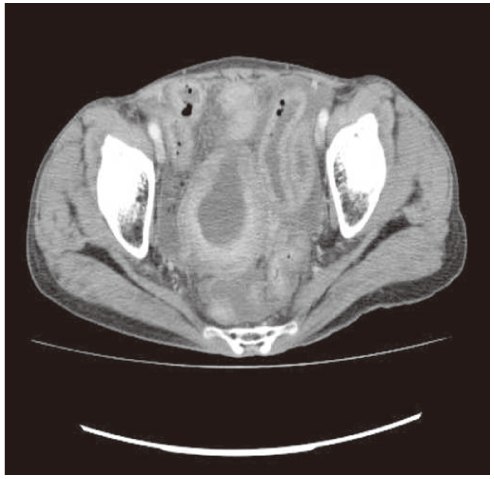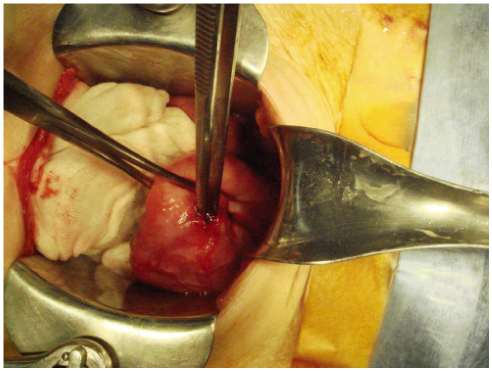Korean J Obstet Gynecol.
2012 Jun;55(6):437-440. 10.5468/KJOG.2012.55.6.437.
Spontaneous uterine perforation of pyometra presented as an acute abdomen: A case report
- Affiliations
-
- 1Department of Obstetrics and Gynecology, Konkuk University Chungju Hospital, Konkuk University School of Medicine, Chungju, Korea. dychung@kku.ac.kr
- 2Department of Radiology, Konkuk University Chungju Hospital, Konkuk University School of Medicine, Chungju, Korea.
- 3Department of Surgery, Konkuk University Chungju Hospital, Konkuk University School of Medicine, Chungju, Korea.
- 4Department of Urology, Konkuk University Chungju Hospital, Konkuk University School of Medicine, Chungju, Korea.
- KMID: 1783940
- DOI: http://doi.org/10.5468/KJOG.2012.55.6.437
Abstract
- Pyometra is an uncommon condition in general population and caused by impairment of natural drainage of the cervix as a result of benign or malignant diseases. Spontaneous uterine perforation, a very rare complication of pyometra, carries significant morbidity and mortality and should be considered in the differential diagnosis of other peritonitis. Preoperative diagnosis of perforated pyometra is difficult due to old age, poor general condition, and symptoms that present as abdominal pain related to gastrointestinal diseases. If a diagnosis of perforated pyometra is delayed, then it will be associated with increased morbidity and mortality. In the causes of uterine perforation, pyometra should be considered because of requiring proper intervention. A diagnosis of spontaneous perforated pyometra should always be kept as a possibility in all cases of abdominal pains associated with peritonitis in elderly women.
MeSH Terms
Figure
Reference
-
1. Geranpayeh L, Fadaei-Araghi M, Shakiba B. Spontaneous uterine perforation due to pyometra presenting as acute abdomen. Infect Dis Obstet Gynecol. 2006. 2006:60276.2. Inui A, Nitta A, Yamamoto A, Kang SM, Kanehara I, Tanaka H, et al. Generalized peritonitis with pneumoperitoneum caused by the spontaneous perforation of pyometra without malignancy: report of a case. Surg Today. 1999. 29:935–938.3. Nuamah NM, Hamaloglu E, Konan A. Spontaneous uterine perforation due to pyometra presenting as acute abdomen. Int J Gynaecol Obstet. 2006. 92:145–146.4. Yildizhan B, Uyar E, Sişmanoğlu A, Güllüoğlu G, Kavak ZN. Spontaneous perforation of pyometra. Infect Dis Obstet Gynecol. 2006. 2006:26786.5. Chan KS, Tan CK, Mak CW, Chia CC, Kuo CY, Yu WL. Computed tomography features of spontaneously perforated pyometra: a case report. Acta Radiol. 2006. 47:226–227.6. Imachi M, Tanaka S, Ishikawa S, Matsuo K. Spontaneous perforation of pyometra presenting as generalized peritonitis in a patient with cervical cancer. Gynecol Oncol. 1993. 50:384–388.7. Vyas S, Kumar A, Prakash M, Kapoor R, Kumar P, Khandelwal N. Spontaneous perforation of pyometra in a cervical cancer patient: a case report and literature review. Cancer Imaging. 2009. 9:12–14.8. Nakao A, Mimura H, Fujisawa K, Ezawa K, Okamoto T, Iwagaki H, et al. Generalized peritonitis due to spontaneously perforated pyometra presenting as pneumoperitoneum: report of a case. Surg Today. 2000. 30:454–457.9. Lee SL, Huang LW, Seow KM, Hwang JL. Spontaneous perforation of a pyometra in a postmenopausal woman with untreated cervical cancer and "forgotten" intrauterine device. Taiwan J Obstet Gynecol. 2007. 46:439–441.10. Chen PH, Hsien L, Lee SL, Chang CY, Chang CC. Pneumoperitoneum caused by perforation of pyometra associated with a lost intrauterine device and perforated malignancy of the sigmoid colon. Taiwan J Obstet Gynecol. 2011. 50:124–125.11. Li CH, Chang WC. Spontaneous perforated pyometra with an intrauterine device in menopause: a case report. Jpn J Infect Dis. 2008. 61:477–478.12. Lien WC, Ong AW, Sun JT, Tsai MT, Lai TI, Liu YP, et al. Pyometra: a potentially lethal differential diagnosis in older women. Am J Emerg Med. 2010. 28:103–105.13. Saha PK, Gupta P, Mehra R, Goel P, Huria A. Spontaneous perforation of pyometra presented as an acute abdomen: a case report. Medscape J Med. 2008. 10:15.
- Full Text Links
- Actions
-
Cited
- CITED
-
- Close
- Share
- Similar articles
-
- Spontaneous uterine perforation due to pyometra presenting as acute abdomen in older age
- A case of generalized peritonitis secondary to a perforated pyometra in a patient with cervical cancer
- Pneumoperitoneum Caused by the Spontaneous Perforation of a Pyometra in an 80-Year-Old Woman: A Case Report
- Spontaneous Perforation of Pyometra Leading to Acute Abdomen
- Spontaneous Perforation of Pyometra




